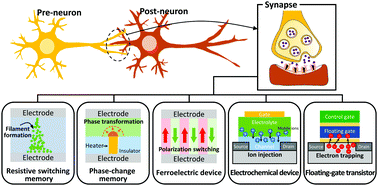Emerging memory devices for artificial synapses
Abstract
Increasing demands for new computing systems to fulfill enormous information processing have driven the development of brain-inspired neuromorphic systems that can perform fast and energy-efficient computing. Neuromorphic computing requires efficient artificial synapses. Emerging memory devices to replace complementary metal-oxide semiconductors are being evaluated. This paper reviews recent developments in artificial synapses that exploit emerging memory devices for use in neuromorphic devices and systems. The synaptic behaviors and plasticity are described to provide the analogy between biological and artificial synapses, then the operation mechanism and emulation of synaptic plasticity using various materials and structures are provided. The remaining challenges and outlooks in the development of artificial synapses that use emerging memory devices are outlined.



 Please wait while we load your content...
Please wait while we load your content...